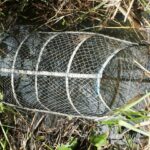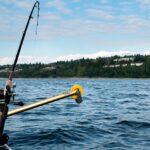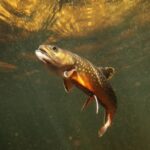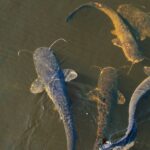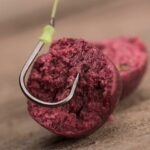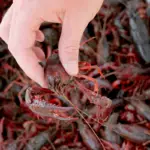People have used fish traps to catch fish for thousands of years. These devices are highly effective and can be used in any type of water and water bodies of any size. Fish traps are useful for all fish species, including baitfish and large fish species, but you have to know where to place and how to use these traps to get the best results.
The best locations for fish traps include areas with a lot of fish activity, near the water’s edge, in deep water for large fish, in shallow water for small fish, near fish holes, near tree lines, fish spawning grounds, in sunlight with reflective lures, and along reefs for trapping ocean fish.
There are multiple techniques that can be used with fish traps, and every fish trap design has its own preferred methods for the best results. However, some general rules can be applied to all fish traps to help you catch the most fish possible and trap the fish that you are targeting without much effort at all.
Where Do You Put A Fish Trap?
Knowing where to place a fish trap is part of using a fish trap. Without placing a fish trap well, the trap is far less likely to be successful.
The best-placed fish traps are highly successful, catch multiple fish with every cycle, and can be replaced quickly for a bigger yield.
The most important thing to know when learning to place fish traps is that there are different locations and methods for trapping different types, species, and sizes of fish.
Understanding these fundamentals is critical for using a fish trap well, but you will learn to find the best locations through practice and experience as you become more proficient with using fish traps.
With that said, here are the best locations for fish traps based on specific fish targets and water types.
Place Fish Traps Where There Is Known Fish Activity
The most obvious place for a fish trap is where you can see fish activity. The best way to place a fish trap is to scout the area and look for the areas of water with the highest fish activity.
If you can, observe an area over multiple days, and find out where the fish like to congregate and where they look for food.
When you have identified these locations, sink your fish trap where the fish are frequently found. Bait the trap for the best results and check the fish trap frequently to ensure that the fish survive.
It is best to place a trap like this early in the day, as fish that are active in the day are more likely to swim into a baited fish trap during the day. Most fish like these are inactive or at least do not feed at night.
Place Fish Traps Near Plants
Another excellent place for fish traps, especially traps that you want to use long-term, is near plants.
Plants are usually frequented by fish as hiding places from predators and areas to look for food. Insects gather around plants for food and places to land, which attracts fish to the same areas.
Look for fish-accessible locations near plants close to the water surface or in the water.
The chances of catching fish in traps in these locations are very high, especially if you bait the traps with insects such as crickets.

Place Fish Traps Near The Edge Of The Water
The edges of the waterline are very good areas to place fish traps. Fish often frequent the edges of bodies of water for safety from larger fish that cannot easily swim in shallow water, to look for hiding places, and to find food.
If you use a fish trap near the edge of the water, be sure that the trap is somewhat see-through to prevent the fish from seeing the trap as an obstacle and avoiding it.
Look for areas along the water line with water deep enough for your trap and deep enough for fish but not so deep that large fish frequent the area.
This will provide the best chance of catching multiple fish within the same trap, especially if you bait with items like bread that are preferred by smaller fish.
Place Fish Traps In Deep Water For Big Fish
If you have designed your traps for catching larger fish specimens, the best place to put the traps is in deeper water.
Large fish rarely venture to shallow water, and the traps must therefore be placed in water that is deep enough for larger fish.
However, the trap cannot be placed in water that is too deep for prey fish. Large fish only swim where there are other fish to eat. Place your trap, baited with minnows or bait fish, into water that is deep enough for larger fish and frequented by smaller fish, and your trap is likely to be successful.
Scout the area for a day or two to find out where the larger fish tend to hang around and look for areas where the fish are likely to be, such as near plants or where there are plenty of insects.
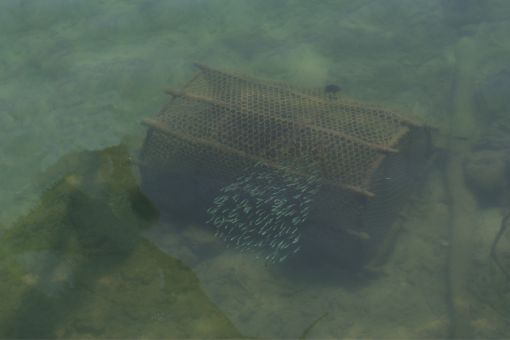
Place Fish Traps In Shallow Water for Small Fish
If you have made traps to catch baitfish for catching larger fish, the best location for the trap is in shallow water. The water does not need to be very shallow, nor on the edge of the water, but in an area that is shallow enough for smaller fish to feel safe from predatory fish.
Bait the trap with food items that smaller fish seek, such as maize bran, oatmeal, crickets, bread, or a fish carcass, and ensure that the trap is placed in an area with good water flow.
Shallow water without good flow has low oxygen levels and is not frequented by fish. Look for good, clear water that is flowing and not too deep, and your trap is likely to catch multiple smaller fish.
Place Fish Traps Near Tree Lines
Tree lines are excellent locations for fish traps. These areas provide a lot of food and hiding places for fish, so they are naturally drawn to areas like these.
The water is often shadowy and still in these areas, which are also good for fish traps. The more still yet oxygenated the water is, the more easily the fish can move around and find food, which means they are more likely to find their way into your trap.
It is best to bait traps placed in these areas, but traps near tree lines tend to work better if you find the right spots.
Place Fish Traps Near Spawning Grounds
One of the best places for a fish trap is near spawning grounds. This is especially true for species that have regular spawning grounds, such as catfish.
Placing a baited trap near the areas where fish spawn is among the best ways to catch as many fish as possible.
It is critical that you place these traps in these areas during the spawning season, or the likelihood of catching anything is slim, but if you place the traps at the right time of year, you may need to empty your traps every hour, as they will fill up with fish quickly.
Spawning grounds are excellent locations for traps if you can find them. If the spawning grounds are inaccessible, place your traps downstream from the spawning grounds to catch the fish as they leave the area.
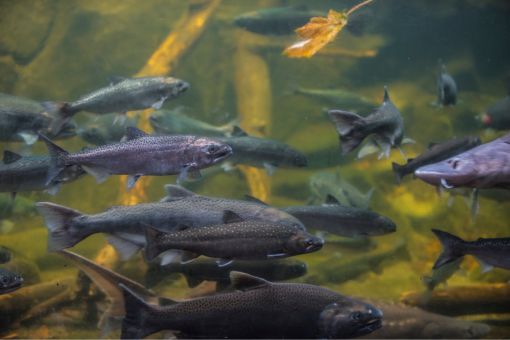
Place Fish Traps Near Fish Holes
Fish holes are common in river bands and the banks of lakes. Fish find holes in the earth in these locations and use them to look for food and hide from predators.
If you happen to find such a hole or know where one is, place a long fish trap directly in front of the hole during the day, and be sure to bait the trap.
The fish are already looking for food in the area and are not used to a trap in front of the hole, so they will swim into the trap before realizing what has happened.
It is important to remove the trap after catching the fish. Only place it in front of the hole once a week or so, or fish will learn of the trap and stop frequenting the hole, ending the supply of fish from that location.
Suspend Fish Traps At Mid-Depth
Sometimes the best place for a fish trap is not at the bottom of the water but rather suspended at mid-depth.
This can be a tricky setup to achieve, but if you have some floatation devices or buoys, you can set a trap to float at mid-depth in a lake, dam, or river.
Some fish species stay at this depth rather than swimming too deep, and you are likely to catch some very large specimens if you go far away from the shore.
Take the time to scout the area, look for fish in the mid-depth of the water, and suspend some baited traps in the areas where you see fish.
These traps must be baited, or they tend to fail. It is better to suspend as many traps as possible for the best results.
Place Fish Traps In The Flow Of A River
If you find a river with a large population of fish, a good location for a trap is directly in the river’s flow. If your trap is wide enough and designed as a funnel, the river will draw fish into it even if it is not baited.
This ancient fish trapping method is used worldwide and is very effective, especially during the seasons when fish are breeding or most active.
Learn the habits of the fish you are trying to trap and learn where the river flows. Simply placing an empty trap in the right location can quickly trap several fish.
Trapping fish is as much of a skill as all other fishing techniques, and learning to use the water to your advantage is an essential aspect of this skill.
Place Fish Traps Where Fish Can Hide
Another ancient fish trapping technique is placing your trap so that fish think it is a good place to hide.
This works best if your trap is solid and placed in areas where fish already know there are hiding places. These traps are easy to build and they are easy to maintain. But it is critical to set them in a place that will trick fish into thinking they are nothing more than debris, a hole in the ground, or a safe spot under a tree root.
These traps do not need to be baited, and they work well even overnight.
It can take longer to trap fish like this, but you can use methods to speed up the process, such as scaring the fish into the general area of the trap and hoping that they will hide in it.
Make these traps from solid materials rather than from mesh or wire, and be sure to check the trap very frequently to catch your fish before they die.
Place Fish Traps In Sunlight
A little-known method for placing fish traps is to place them in an area of water that experiences a lot of direct sunlight throughout the day.
This method works well when combining your trap with a shiny lure or attractive-looking bait such as oatmeal.
The sunlight will reflect off the lure or bait and draw fish in. Traps used in this way must be made from material that the fish can see through, such as mesh or wire, and the bait or lures placed in the trap must be as attractive as possible.
This method works surprisingly well and is especially useful for catching aggressive hunting fish species, such as bass.
Use this method in a river or in the ocean. It works best where there are large numbers of fish present in the water.
There is much trial and error involved with this method, but when you get it right and find the right location, you are sure to catch a lot of fish in your traps.
Place Fish Traps Where The Tide Goes out
If you are using fish traps in the ocean, a good method is to place the traps where the water is high during high tide and low during low tide. Tidal pools, rock pools, lagoons, and bays are all good locations for this.
Scout the areas beforehand and look for places with a lot of fish. Ensure that the traps you use are quite small but big enough to catch the fish you are after.
When you find the right location, place the traps during high tide. Wait for the tide to go out, and fish will likely be found in your traps.
This method works because the fish become easily trapped as the water level drops, especially if they are in confined areas such as tidal pools.
This method works especially well when the traps are baited, but bait is not necessary for these traps to work.
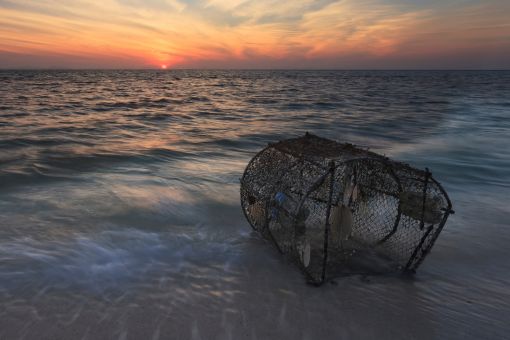
Place Fish Traps Along Reefs
If you are catching marine fish, natural reefs are the best place to do so. These locations are where fish find the most food and the best hiding places, so they are the best places to trap coastal fish.
It is best to use multiple traps when trapping on reefs and always bait the traps with items that the fish want to eat.
Fish carcasses, shrimp, shellfish, baitfish, and table scraps are excellent options here.
Place the traps at the reef during the day, move away from the trap, and wait for it to work. The busier the reef is, the more likely it is to work, and the better the bait, the quicker it will trap fish.
It is critical that traps used at ocean reefs are sturdy and able to withstand sea currents, sharp rocks, and even strong marine animals such as octopuses that may try to break the trap to get the bait within.

Place Fish Traps In Rapids
This may seem somewhat unconventional, but it is a trap placement that has been used in African countries for generations.
Place basked-like traps anchored within fast-flowing river rapids, and you will likely easily trap fish caught in the river current. These traps act as a kind of sieve and catch fish as they are carried downstream.
This method is most effective during the seasons when fish are breeding or most active, but it does work well all year. No bait is needed for these traps.
Conclusion
There are several ways and locations to place fish traps, and understanding the best options for you is critical for trapping fish successfully. Take the time to find the best locations and methods for the fish you want to trap and the type of trap you use, and you are sure to catch fish quickly.
There is no exact right formula for trapping fish, and much of it is trial and error, but if you take the time to master it, you will quickly develop an eye for the best trap locations.
- Do You Need An Indicator For Nymph Fishing? - November 16, 2023
- Fishing Safety Tips For Families - September 25, 2023
- What Is The Best Time To Night Fish At A Lake? - September 18, 2023

